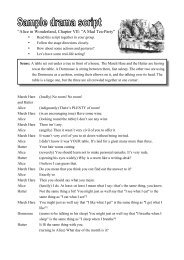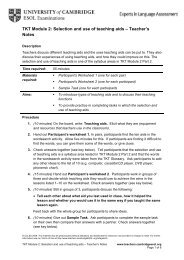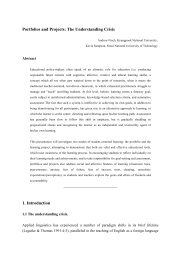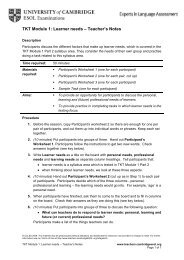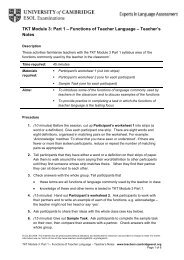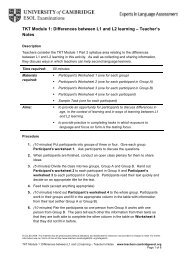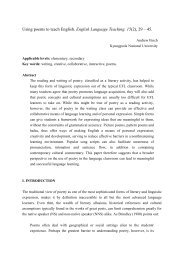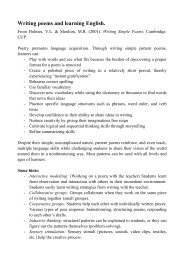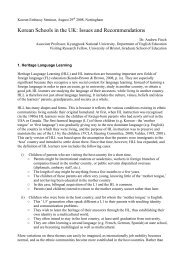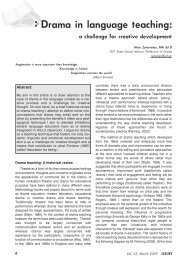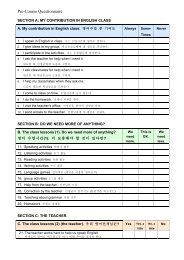Teacher language: Appropriacy of use - Finchpark
Teacher language: Appropriacy of use - Finchpark
Teacher language: Appropriacy of use - Finchpark
You also want an ePaper? Increase the reach of your titles
YUMPU automatically turns print PDFs into web optimized ePapers that Google loves.
TKT Module 3: <strong>Teacher</strong> <strong>language</strong>: <strong>Appropriacy</strong> <strong>of</strong> <strong>use</strong> – <strong>Teacher</strong>’s<br />
Notes<br />
Description<br />
Participants consider the main features <strong>of</strong> teacher <strong>language</strong>, and discuss the appropriacy <strong>of</strong><br />
some examples <strong>of</strong> teacher <strong>language</strong>. They practise different sample tasks from TKT Module<br />
3 Part 1 to explore how this syllabus area <strong>of</strong> teacher <strong>language</strong> and ‘appropriacy <strong>of</strong> <strong>use</strong>’ in<br />
teacher <strong>language</strong> in the classroom is tested.<br />
Time required:<br />
Materials<br />
required:<br />
55 minutes<br />
• Participant’s Worksheet 1 (one for each participant)<br />
• Participant’s Worksheet 2 (one for each participant)<br />
• Participant’s Worksheet 3 (one for each participant in Group A)<br />
• Participant’s Worksheet 4 (one for each participant in Group B)<br />
• Participant’s Worksheet 5 (one for each participant in Group C)<br />
• Participant’s Worksheet 6 (one for each pair <strong>of</strong> students)<br />
Aims: • To raise awareness and to discuss aspects relating to appropriacy<br />
<strong>of</strong> <strong>use</strong> <strong>of</strong> teacher <strong>language</strong> in the classroom.<br />
• To provide practice in completing tasks in which appropriacy <strong>of</strong><br />
teacher <strong>language</strong> is the testing focus.<br />
Procedure<br />
1. (10 minutes) On the board, write: <strong>Teacher</strong> <strong>language</strong> – appropriacy <strong>of</strong> <strong>use</strong>. Elicit<br />
some ideas <strong>of</strong> what participants understand by this, then add to the board: <strong>language</strong><br />
which is suitable for the teacher to <strong>use</strong> in the classroom.<br />
2. Give out Participant’s worksheet 1. In groups <strong>of</strong> three, participants find six words in<br />
the word search that describe the type <strong>of</strong> <strong>language</strong> which is suitable for the teacher<br />
to <strong>use</strong> in the classroom. Set a time limit <strong>of</strong> five minutes.<br />
3. Check answers together (see key below). Explain that appropriacy <strong>of</strong> <strong>use</strong> in teacher<br />
<strong>language</strong> in the class is tested in TKT Module 3 Part 1. This includes degrees <strong>of</strong><br />
simplicity <strong>of</strong> <strong>language</strong> and degrees <strong>of</strong> formality.<br />
4. (15 minutes) Hand out Participant’s worksheet 2. In pairs, participants discuss<br />
whether the examples <strong>of</strong> teacher <strong>language</strong> on the worksheet are appropriate or<br />
inappropriate, and give their reasons for their answers. Check answers together.<br />
5. (15 minutes) Divide participants into three groups, Group A, Group B and Group C.<br />
Give Group A Participant’s worksheet 3, Group B Participant’s worksheet 4 and<br />
Group C Participant’s worksheet 5. Participants complete their tasks in their<br />
groups.<br />
© UCLES 2009. This material may be photocopied (without alteration) and distributed for classroom <strong>use</strong> provided no charge is made. For further<br />
information see our Terms <strong>of</strong> Use at http://www.teachers.cambridgeESOL.org/ts/legalinfo<br />
TKT Module 3: <strong>Teacher</strong> <strong>language</strong>: <strong>Appropriacy</strong> <strong>of</strong> <strong>use</strong> – <strong>Teacher</strong>’s Notes<br />
www.teachers.cambridgeesol.org<br />
Page 1 <strong>of</strong> 9
6. Give out Participant’s worksheet 6, which has the answers to all three tasks for<br />
participants to check in pairs.<br />
7. (10 minutes) Re-group participants into new groups <strong>of</strong> three. Each group should<br />
have one person from each group, A, B and C. Participants tell their new group about<br />
the tasks they have just completed. They should discuss the following:<br />
<br />
What type <strong>of</strong> task was it, e.g. matching, multiple choice, etc<br />
<br />
What was the testing focus for the task, e.g. appropriacy <strong>of</strong> instructions,<br />
<strong>use</strong> <strong>of</strong> L1, sequencing instructions<br />
8. Feed back together to discuss answers to Step 7 (see key below).<br />
9. (5 minutes) Round up to summarise points covered. Ask participants:<br />
• What is the TKT Module 3 syllabus area for this lesson (appropriacy <strong>of</strong><br />
<strong>language</strong> <strong>use</strong>d by the teacher in the classroom)<br />
• What are candidates being tested on (Candidates are tested on degrees <strong>of</strong><br />
simplicity <strong>of</strong> <strong>language</strong> <strong>use</strong>d by the teacher, the appropriateness <strong>of</strong> sequencing<br />
instructions, degrees <strong>of</strong> formality in <strong>language</strong> <strong>use</strong>d and teachers’ <strong>use</strong> <strong>of</strong> L1 in the<br />
classroom.)<br />
© UCLES 2009. This material may be photocopied (without alteration) and distributed for classroom <strong>use</strong> provided no charge is made. For further<br />
information see our Terms <strong>of</strong> Use at http://www.teachers.cambridgeESOL.org/ts/legalinfo<br />
TKT Module 3: <strong>Teacher</strong> <strong>language</strong>: <strong>Appropriacy</strong> <strong>of</strong> <strong>use</strong> – <strong>Teacher</strong>’s Notes<br />
www.teachers.cambridgeesol.org<br />
Page 2 <strong>of</strong> 9
TKT Module 3: <strong>Teacher</strong> <strong>language</strong>: <strong>Appropriacy</strong> <strong>of</strong> <strong>use</strong> – Answer<br />
Keys<br />
Key to Participant’s Worksheet 1<br />
simple, polite, clear, direct, informal, formal<br />
S C L E A R D F<br />
P H S J W N P O<br />
O K A I Q X U R<br />
L O Z P M W C M<br />
I P L E X P M A<br />
T C Y A R E L L<br />
E D I R E C T E<br />
B C C L T W O P<br />
I N F O R M A L<br />
(first letter <strong>of</strong> words in dark grey)<br />
Key to Participant’s Worksheet 2<br />
1. appropriate<br />
2. probably inappropriate beca<strong>use</strong> the <strong>language</strong> is too complicated for an elementary<br />
student (not clear)<br />
3. inappropriate. This <strong>language</strong> is too childish for a teenager (wrong register).<br />
4. inappropriate. The <strong>language</strong> and the ideas are too complicated and abstract for this<br />
age group (not clear).<br />
5. inappropriate: too childish for <strong>use</strong> with adult learners (wrong register)<br />
6. inappropriate: it is rude and disrespectful (impolite)<br />
7. appropriate<br />
8. inappropriate: too casual and vague (too informal)<br />
9. appropriate.<br />
10. inappropriate for this student (insensitive)<br />
Key to Procedure Step 8<br />
Task Task type Testing focus<br />
A – Participant’s worksheet 3 3 option matching task teachers’ <strong>use</strong> <strong>of</strong> L1 in the<br />
classroom<br />
B – Participant’s worksheet 4<br />
one–to–one matching<br />
task<br />
appropriacy <strong>of</strong> <strong>language</strong> in<br />
instructions<br />
C – Participant’s worksheet 5 multiple choice task sequencing instructions<br />
© UCLES 2009. This material may be photocopied (without alteration) and distributed for classroom <strong>use</strong> provided no charge is made. For further<br />
information see our Terms <strong>of</strong> Use at http://www.teachers.cambridgeESOL.org/ts/legalinfo<br />
TKT Module 3: <strong>Teacher</strong> <strong>language</strong>: <strong>Appropriacy</strong> <strong>of</strong> <strong>use</strong> – Answer Keys<br />
www.teachers.cambridgeesol.org<br />
Page 3 <strong>of</strong> 9
TKT Module 3: <strong>Teacher</strong> <strong>language</strong>: <strong>Appropriacy</strong> <strong>of</strong> <strong>use</strong> –<br />
Participant’s Worksheet 1<br />
Find six words to describe the type <strong>of</strong> <strong>language</strong> teachers should <strong>use</strong> in the<br />
classroom.<br />
S C L E A R D F<br />
P H S J W N P O<br />
O K A I Q X U R<br />
L O Z P M W C M<br />
I P L E X P M A<br />
T C Y A R E L L<br />
E D I R E C T E<br />
B C C L T W O P<br />
I N F O R M A L<br />
TKT Module 3: <strong>Teacher</strong> <strong>language</strong>: <strong>Appropriacy</strong> <strong>of</strong> <strong>use</strong> –<br />
Participant’s Worksheet 1<br />
Find six words to describe the type <strong>of</strong> <strong>language</strong> teachers should <strong>use</strong> classroom.<br />
S C L E A R D F<br />
P I S J W N P O<br />
O K M I Q X U R<br />
L O Z P M W C M<br />
I P L E L P M A<br />
T C Y A R E L L<br />
E D I R E C T E<br />
B C C L E A R P<br />
I N F O R M A L<br />
© UCLES 2009. This material may be photocopied (without alteration) and distributed for classroom <strong>use</strong> provided no charge is made. For further<br />
information see our Terms <strong>of</strong> Use at http://www.teachers.cambridgeESOL.org/ts/legalinfo<br />
TKT Module 3: <strong>Teacher</strong> <strong>language</strong>: <strong>Appropriacy</strong> <strong>of</strong> <strong>use</strong> – Participant’s Worksheet 1<br />
www.teachers.cambridgeesol.org<br />
Page 4 <strong>of</strong> 9
TKT Module 3: <strong>Teacher</strong> <strong>language</strong>: <strong>Appropriacy</strong> <strong>of</strong> <strong>use</strong> –<br />
Participant’s Worksheet 2<br />
Work with a partner and discuss whether the examples <strong>of</strong> teacher <strong>language</strong> are appropriate<br />
or inappropriate. Give reasons for your answers.<br />
1. Said to a class <strong>of</strong> elementary secondary students:<br />
‘Please tell me your names.’<br />
2. Said to an adult elementary learner:<br />
‘I believe that your hard work has really produced results. Congratulations!’<br />
3. Said to a teenage intermediate student:<br />
‘You clever boy! Your mummy will be pleased with your mark.’<br />
4. Said to a group <strong>of</strong> 9–10 year old intermediate students:<br />
‘While it is possible to <strong>use</strong> the past tense here, it’s much more common and natural<br />
to <strong>use</strong> the present simple instead.’<br />
5. Said to a group <strong>of</strong> advanced adult business students:<br />
‘What excellent work. You really have been very, very good students.’<br />
6. Said to an elementary adult student:<br />
‘This work is awful - careless and poor quality. Do it again.’<br />
7. Said to a group <strong>of</strong> teenage intermediate students:<br />
‘Could you get into groups and check your answers together’<br />
8. Said to a group <strong>of</strong> secondary beginners:<br />
‘Just get into groups and do the writing.’<br />
9. Said to a group <strong>of</strong> primary intermediate students:<br />
‘Colour the pictures for homework, and write the names <strong>of</strong> the objects under each<br />
picture. OK’<br />
10. Said to an adult student who is very shy:<br />
‘OK. Stand up and sing us the song.’<br />
© UCLES 2009. This material may be photocopied (without alteration) and distributed for classroom <strong>use</strong> provided no charge is made. For further<br />
information see our Terms <strong>of</strong> Use at http://www.teachers.cambridgeESOL.org/ts/legalinfo<br />
TKT Module 3: <strong>Teacher</strong> <strong>language</strong>: <strong>Appropriacy</strong> <strong>of</strong> <strong>use</strong> – Participant’s Worksheet 2<br />
www.teachers.cambridgeesol.org<br />
Page 5 <strong>of</strong> 9
TKT Module 3: <strong>Teacher</strong> <strong>language</strong>: <strong>Appropriacy</strong> <strong>of</strong> <strong>use</strong> –<br />
Participant’s Worksheet 3<br />
Task A<br />
For questions 1–6, match what the teacher is doing with the purposes for using the students’<br />
first <strong>language</strong>, listed A, B and C.<br />
Mark the correct letter (A, B or C) on your answer sheet.<br />
Purposes for using the students’ first <strong>language</strong><br />
A<br />
B<br />
C<br />
checking understanding<br />
explaining procedures<br />
motivating<br />
The teacher is<br />
1 asking students to show they know what to do for homework.<br />
2 giving individual written feedback to a weak student.<br />
3 encouraging elementary students to try new ways <strong>of</strong> learning.<br />
4 telling a large group <strong>of</strong> teenagers the rules <strong>of</strong> a game.<br />
5 asking students to translate the meaning <strong>of</strong> new words.<br />
6 showing a group <strong>of</strong> beginners exactly how to <strong>use</strong> a self-access centre.<br />
© UCLES 2009. This material may be photocopied (without alteration) and distributed for classroom <strong>use</strong> provided no charge is made. For further<br />
information see our Terms <strong>of</strong> Use at http://www.teachers.cambridgeESOL.org/ts/legalinfo<br />
TKT Module 3: <strong>Teacher</strong> <strong>language</strong>: <strong>Appropriacy</strong> <strong>of</strong> <strong>use</strong> – Participant’s Worksheet 3<br />
www.teachers.cambridgeesol.org<br />
Page 6 <strong>of</strong> 9
TKT Module 3: <strong>Teacher</strong> <strong>language</strong>: <strong>Appropriacy</strong> <strong>of</strong> <strong>use</strong> –<br />
Participant’s Worksheet 4<br />
Task B<br />
For questions 1–6, match the teacher’s instructions to an elementary class with the teacher<br />
trainer’s comments, listed A–G. Mark the correct letter (A, B or C) on your answer sheet.<br />
There is one extra option which you do not need to <strong>use</strong>.<br />
<strong>Teacher</strong>’s instructions<br />
1 Compare your answers with what the others have written down. Oh, first you should get<br />
into groups.<br />
2 Write the essay tonight and hand it in tomorrow, please.<br />
3 Now, we’re going to move on to the role play on page 7. Read the instructions and start<br />
when you’re ready. OK, <strong>of</strong>f you go!<br />
4 Can anybody tell me the answer to number 1<br />
5 Right, could you all turn to page 72. Or is it 62 Wait a minute, I’ll just look…it’s 52. Sorry.<br />
6 Sorry, no more time for questions. We need to move on. We’ve got a lot to get through this<br />
morning.<br />
<strong>Teacher</strong> trainer’s comments<br />
A I don’t think you’ve allowed them enough time, check that they don’t have any other homework<br />
to do.<br />
B<br />
C<br />
D<br />
E<br />
F<br />
G<br />
You need to think before you speak and decide on the order you want the class to do things<br />
in.<br />
Don’t be in such a hurry to start new work – it’s more important for students to understand<br />
what they’ve done so far.<br />
Check references in your lesson plan in advance, not while you’re giving the instructions.<br />
Try to avoid repeating yourself – it doesn’t necessarily make students understand instructions<br />
any better.<br />
It’s better to nominate a particular student, rather then asking the whole class, in order to give<br />
the weaker ones a chance.<br />
Always check students have understood your instructions. A demonstration <strong>of</strong> the activity is a<br />
good idea.<br />
© UCLES 2009. This material may be photocopied (without alteration) and distributed for classroom <strong>use</strong> provided no charge is made. For further<br />
information see our Terms <strong>of</strong> Use at http://www.teachers.cambridgeESOL.org/ts/legalinfo<br />
TKT Module 3: <strong>Teacher</strong> <strong>language</strong>: <strong>Appropriacy</strong> <strong>of</strong> <strong>use</strong> – Participant’s Worksheet 4<br />
www.teachers.cambridgeesol.org<br />
Page 7 <strong>of</strong> 9
TKT Module 3: <strong>Teacher</strong> <strong>language</strong>: <strong>Appropriacy</strong> <strong>of</strong> <strong>use</strong> –<br />
Participant’s Worksheet 5<br />
Task C<br />
For questions 1–6 look at the classroom activities and the teachers’ instructions listed A, B and<br />
C. Choose the instruction that would come first, A, B or C. Mark the correct letter (A, B or C) on<br />
your answer sheet.<br />
1<br />
The teacher gives learners an article from a newspaper to read for the first time. The teacher<br />
says:<br />
A<br />
B<br />
C<br />
Discuss what you think about the opinions in the article in pairs.<br />
Read the article quickly and decide on a good title for it.<br />
Look at these 10 questions. The answers are in the text. You have fifteen minutes.<br />
2<br />
The teacher wants to teach learners some new vocabulary connected to food. The teacher<br />
says:<br />
A<br />
B<br />
C<br />
Look at this picture. What is this Yes, good, biscuit.<br />
Listen and repeat – biscuit, all together – biscuit.<br />
Can you make a sentence using the word biscuit<br />
3<br />
The teacher wants learners to practise <strong>language</strong> learnt in the lesson by doing a role play. The<br />
teacher says:<br />
A<br />
B<br />
C<br />
Gina and Laura, come to the front here and do your role play for the whole class.<br />
Look at the cards I have given you. This is some more information about the people.<br />
‘A’s, you are the interviewer and ‘B’s, you are a famous person being interviewed.<br />
4<br />
The teacher wants learners to develop their oral fluency in a discussion activity. The teacher<br />
says:<br />
A Antonio, what did your group think about question number 1<br />
B Talk about these questions in groups. Choose someone to report back for the group.<br />
C There are some comments you made on the board. Can you correct them<br />
5<br />
The teacher wants learners to <strong>use</strong> a recording <strong>of</strong> a song as a listening comprehension<br />
exercise in class. The teacher says:<br />
A<br />
B<br />
C<br />
Read the transcript and underline the words that you don’t know.<br />
Listen and tell me what kind <strong>of</strong> song you think this is: happy sad romantic<br />
While you listen to the song, fill in the gaps in the transcript.<br />
6 The teacher wants to help learners with intonation patterns. The teacher says:<br />
A<br />
B<br />
C<br />
Practise the sentences with your partner. Make sure you sound interested or bored.<br />
Come to the board and write your answers. I if they’re interested and B if they’re bored.<br />
Listen to these people talking. Do they sound interested or bored<br />
© UCLES 2009. This material may be photocopied (without alteration) and distributed for classroom <strong>use</strong> provided no charge is made. For further<br />
information see our Terms <strong>of</strong> Use at http://www.teachers.cambridgeESOL.org/ts/legalinfo<br />
TKT Module 3: <strong>Teacher</strong> <strong>language</strong>: <strong>Appropriacy</strong> <strong>of</strong> <strong>use</strong> – Participant’s Worksheet 5<br />
www.teachers.cambridgeesol.org<br />
Page 8 <strong>of</strong> 9
TKT Module 3: <strong>Teacher</strong> <strong>language</strong>: <strong>Appropriacy</strong> <strong>of</strong> <strong>use</strong> –<br />
Participant’s Worksheet 6<br />
Answers to Participant’s worksheets 3, 4 and 5<br />
Participant’s<br />
worksheet 3: Task A<br />
Participant’s<br />
worksheet 4: Task B<br />
Participant’s<br />
worksheet 5: Task C<br />
1 A 2 C 3 C 4 B 5 A 6 B<br />
1 B 2 A 3 G 4 F 5 D 6 C<br />
1 B 2 A 3 C 4 B 5 B 6 C<br />
TKT Module 3: <strong>Teacher</strong> <strong>language</strong>: <strong>Appropriacy</strong> <strong>of</strong> <strong>use</strong> –<br />
Participant’s Worksheet 6<br />
Answers to Participant’s worksheets 3, 4 and 5<br />
Participant’s<br />
worksheet 3: Task A<br />
Participant’s<br />
worksheet 4: Task B<br />
Participant’s<br />
worksheet 5: Task C<br />
1 A 2 C 3 C 4 B 5 A 6 B<br />
1 B 2 A 3 G 4 F 5 D 6 C<br />
1 B 2 A 3 C 4 B 5 B 6 C<br />
TKT Module 3: <strong>Teacher</strong> <strong>language</strong>: <strong>Appropriacy</strong> <strong>of</strong> <strong>use</strong> –<br />
Participant’s Worksheet 6<br />
Answers to Participant’s worksheets 3, 4 and 5<br />
Participant’s<br />
worksheet 3: Task A<br />
Participant’s<br />
worksheet 4: Task B<br />
Participant’s<br />
worksheet 5: Task C<br />
1 A 2 C 3 C 4 B 5 A 6 B<br />
1 B 2 A 3 G 4 F 5 D 6 C<br />
1 B 2 A 3 C 4 B 5 B 6 C<br />
© UCLES 2009. This material may be photocopied (without alteration) and distributed for classroom <strong>use</strong> provided no charge is made. For further<br />
information see our Terms <strong>of</strong> Use at http://www.teachers.cambridgeESOL.org/ts/legalinfo<br />
TKT Module 3: <strong>Teacher</strong> <strong>language</strong>: <strong>Appropriacy</strong> <strong>of</strong> <strong>use</strong> – Participant’s Worksheet 6<br />
www.teachers.cambridgeesol.org<br />
Page 9 <strong>of</strong> 9



